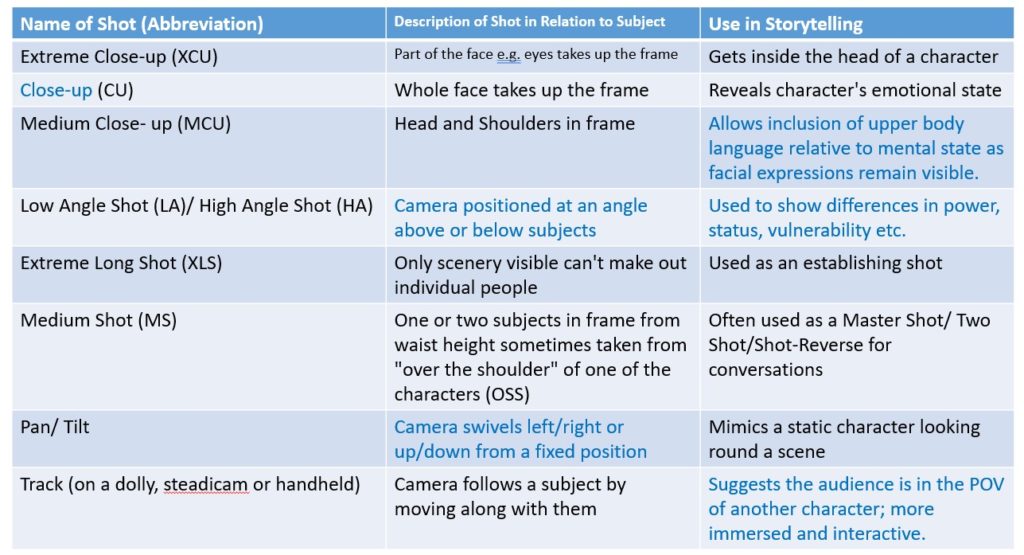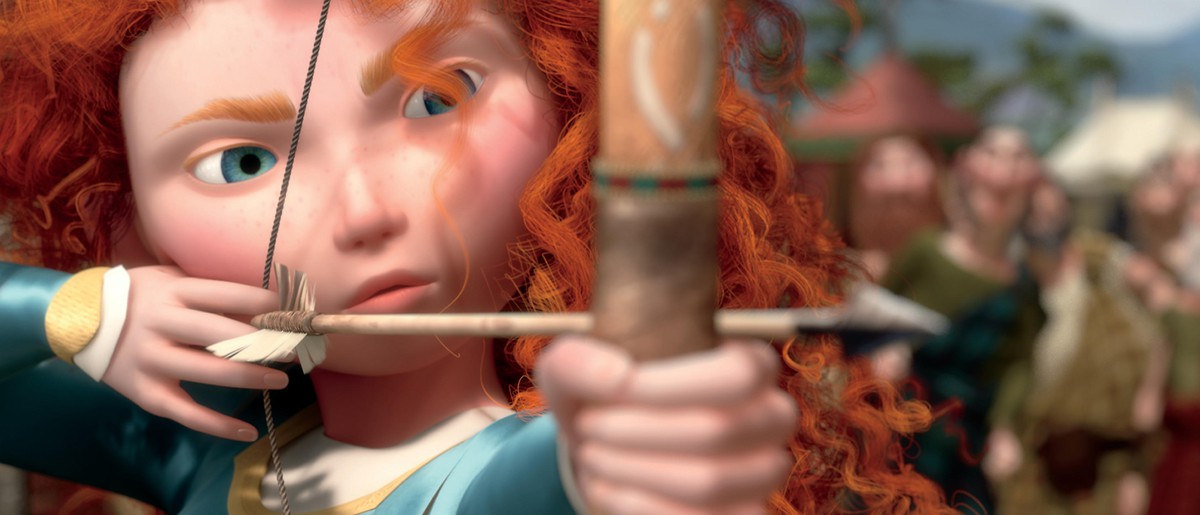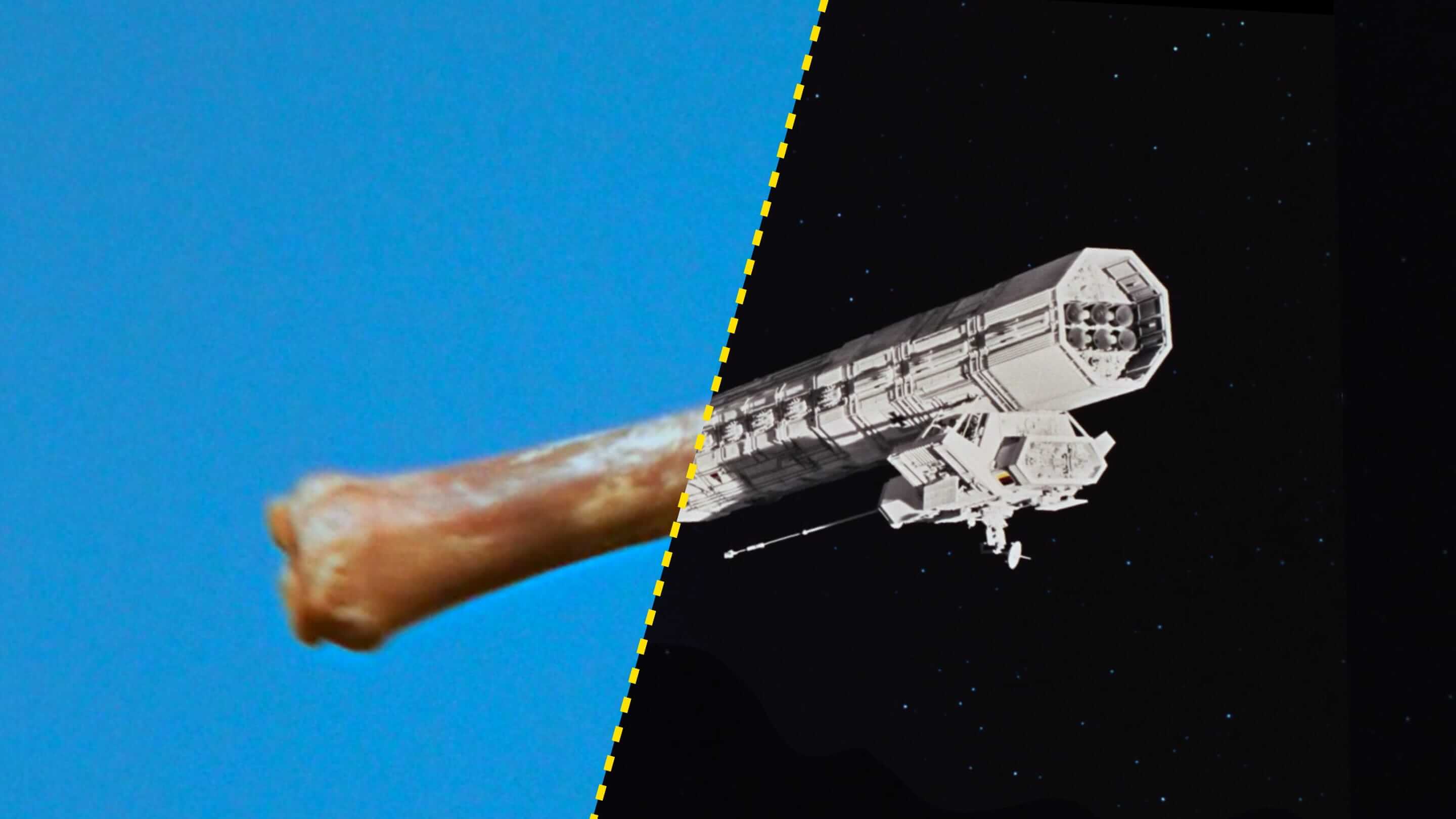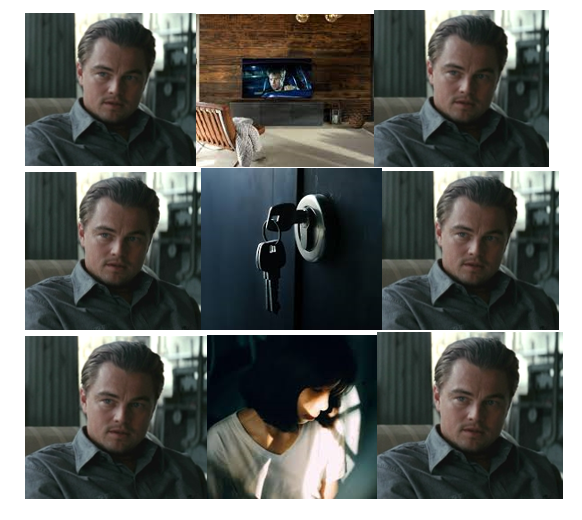
shot types and their uses (table)


PAN (LEFT/RIGHT):
WIKIPEDIA – ‘In cinematography and photography panning means swivelling a still or video camera horizontally from a fixed position. This motion is similar to the motion of a person when they turn their head on their neck from left to right.’
TRACK (OUT/IN):
MASTERCLASS.COM – ‘In cinematography, a tracking shot is any shot in which the camera physically moves sideways, forward, or backward through the scene. Tracking shots usually last longer than other shots, follow one or more moving subjects, and immerse the audience in a particular setting’
DOLLYING VS TRUCKING:
MASTERCLASS.COM – ‘Two common types of tracking shots are dollying and trucking. A dolly shot is when the camera is moved forward or backward along a track. A truck shot is when the camera is moved left or right.’
CRAB (LEFT/RIGHT):
WWW.MEDIACOLLEGE.COM – ‘The term crabbing shot is a less-common version of tracking, trucking and/or dollying. These terms are more or less interchangeable, although dollying tends to mean in-and-out movement whereas the others tend to mean side-to-side movement at a constant distance from the action.’
ZOOM OUT/IN (LENS):
STUDIOBINDER.COM – ‘A zoom shot is when the focal length of a camera lens is adjusted to give the illusion of moving closer or further away from the subject. Zoom shots are done with a zoom lens, which have variable focal lengths. The most typical camera zoom types are the “zoom in” and “zoom out,” but it can also be combined with a dolly shot to create a “dolly zoom.” ‘
PED (UP/DOWN):
OXFORDREFERENCE.COM – ‘In film and video, a track where the camera moves in a vertical direction (along the y-axis). Ped-up and ped-down shots involve motion parallax which creates a feeling of depth, as the relative occlusion of foreground and background elements dynamically changes in the frame‘
TILT (UP/DOWN):
STUDIOBINDER.COM – ‘A tilt shot is shot that uses a cinematographic technique called tilting in which the camera stays fixed but rotates up and down on a vertical plane. Tilting is similar to the motion of an individual raising or lowering their heads. This is different than the panning of a camera which also sits on a fixed but moves left to right. Equipment like a tilt-shift lens enables this vertical camera motion.‘
LOW:
EYE-LEVEL:

HIGH:
WORM’S EYE:

CANTED/DUTCH:

BIRD’S EYE:
Activity: give an example of each shot distance from a film you have watched and explain the effect on the viewer.
Big or Extreme Close Up (BCU/ECU)
Close Up (CU)

Medium Close Up (MCU)

Medium or Mid Shot (MS)

Medium Long Shot (MLS)

Long Shot(LS)

Panoramic Shot

(WRITTEN ELEMENTS NOT FROM SOURCES…. FROM ME?)
MATCH ON ACTION:

The process of aligning or overlapping the shots of a film sequence in order to achieve a smooth transition from the action in one shot to the action of the succeeding shot.
Essentially – transitions/physical movement to connect (parallels etc).
(Source – videocide.com (edited))
GRAPHIC MATCH:

Graphic Match. The term graphic match is one of the many editing techniques used to continuously transition two successive shots. A graphic match creates a cut between two shots that highlight their graphically similar images.
Essentially – two different objects/shots with the same shape used to create emphasis or meaning.
(Source – everythingwhat.com (edited))
EYELINE MATCH:

Eyeline match is an editing technique used to indicate to the audience what a character is seeing. Eyeline match allows the audience to believe that they’re looking at something through the eyes of the character.
Essentially – using point of view for emphasis or perception confirmation when a character is looking at something, or potentially continuity when a subject is looking at another character.
(Source – masterclass.com)
J Cut:
A J cut is an editing technique in which the audio from a following scene overlaps the picture from the preceding scene, so that the audio portion of the later scene starts playing before its picture as a lead-in to the visual cut.
(Source – Wikipedia (edited))
L Cut:
An L cut is an editing technique in which the audio from preceding scene overlaps the picture from the following scene, so that the audio cuts after the picture, and continues playing over the beginning of the next scene.
(Source – Wikipedia (edited))


What went wrong:
There were a couple of times during which we couldn’t decide what shot exactly to use and we could have planned ahead of time to avoid this. Additionally, using our own group as actors lessened efficiency because we couldn’t always be completely serious.
What went well:
Although we couldn’t always decide on a shot, there were many occasions on which we could quickly think of shots that would convey the emotion or message we needed. Our level of creativity seemed to be quite high as we did allow a lot of ideas to flow.
What I would change if I repeated:
I think that the biggest action to take to improve our filming would probably be to plan shots and shot order ahead of time. This would definitely reduce wasted time, as well as the allowance of an overflow of numerous separate ideas.

In Amélie (Jean Pierre-Jeunet, 2001), Audrey Tatou’s protagonist consistently narrates to the audience; breaking the suspension of disbelief to correlate with the light-hearted and comedic tone.
![Shutter Island – [FILMGRAB]](https://encrypted-tbn0.gstatic.com/images?q=tbn:ANd9GcSUxcEFmVlfbajAXfGjsrNzOBPSc2hjgaDgr5YFF3CWegRRuzSIgJUxpKAhgobLlz6yZeI:https://film-grab.com/wp-content/uploads/photo-gallery/13%2520(925).jpg%3Fbwg%3D1547384616&usqp=CAU)
Martin Scorsese’s Shutter Island (2010) allows this low angle shot could be interpreted as an implication of power; giving a clear label to the characters who in this scene appear superior in knowledge and control of their surroundings.

A rare insight into the mind of Halloween’s (1978) main antagonist, Michael Myers is given to the audience through this effective use of introspective focus.